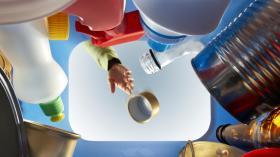
During an experiment, marketing professor Remi Trudel noticed a pattern in what his volunteers were recycling versus throwing in the garbage. He then went through his colleagues' trash and recycling bins at Boston University for more data.
He found the same pattern, says NPR's Shankar Vedantam: "Whole sheets of paper typically went in the recycling, but paper fragments went in the trash."
Same type of paper, different shapes, different bins.
Trudel and fellow researcher Jennifer Argo conducted experiments to figure out why that might be. Volunteers received full pieces of paper as well as fragments, and they also received cans of soda.
"After the volunteers had drunk the soda, when the cans were intact, the cans went in the recycling," Vedantam tells Morning Edition host David Greene. "But if the cans were dented or crushed in any way, the volunteers ended up putting those crushed cans in the trash."
Trudel and Argo developed a theory, which has to do with how we perceive a product's utility.
"When a product is sufficiently distorted or changed in size or form, consumers perceive it as less useful," Trudel says. "And when they perceive it as less useful, they're more likely to throw it in the garbage, as opposed to recycle it."
Vedantam describes it as following an "unconscious rule of thumb."
"After we finish using a product, we somehow evaluate, does the product still look like it could be useful? So a can that isn't dented still looks like a can; it could conceivably still hold soda in it, and so we think of it as being useful," he says.
We have internalized the idea that "useful things go in the recycling, and useless things go in the trash."
Things that could have been recycled actually make up a significant portion of what's thrown in the garbage every year. The Environmental Protection Agency estimatesthat paper and paperboard accounted for 28 percent of waste generated in 2011. Plastics and metals made up an additional 22 percent.
Trudel says the first step in changing these habits is to be aware of our bias about usefulness. He's running experiments to tell people how much energy individual cans are worth, so that something that may seem useless is actually valuable.
"He's also thinking of putting these big red frowny faces on the trash cans as a way to get people to stop for just one second and make a conscious decision," Vedantam says.
Copyright 2013 NPR. To see more, visit http://www.npr.org/.9(MDAxNDQ2NDAxMDEyNzU2NzM2ODA3ZGI1ZA001))
9(MDAxNDQ2NDAxMDEyNzU2NzM2ODA3ZGI1ZA001))

No comments:
Post a Comment